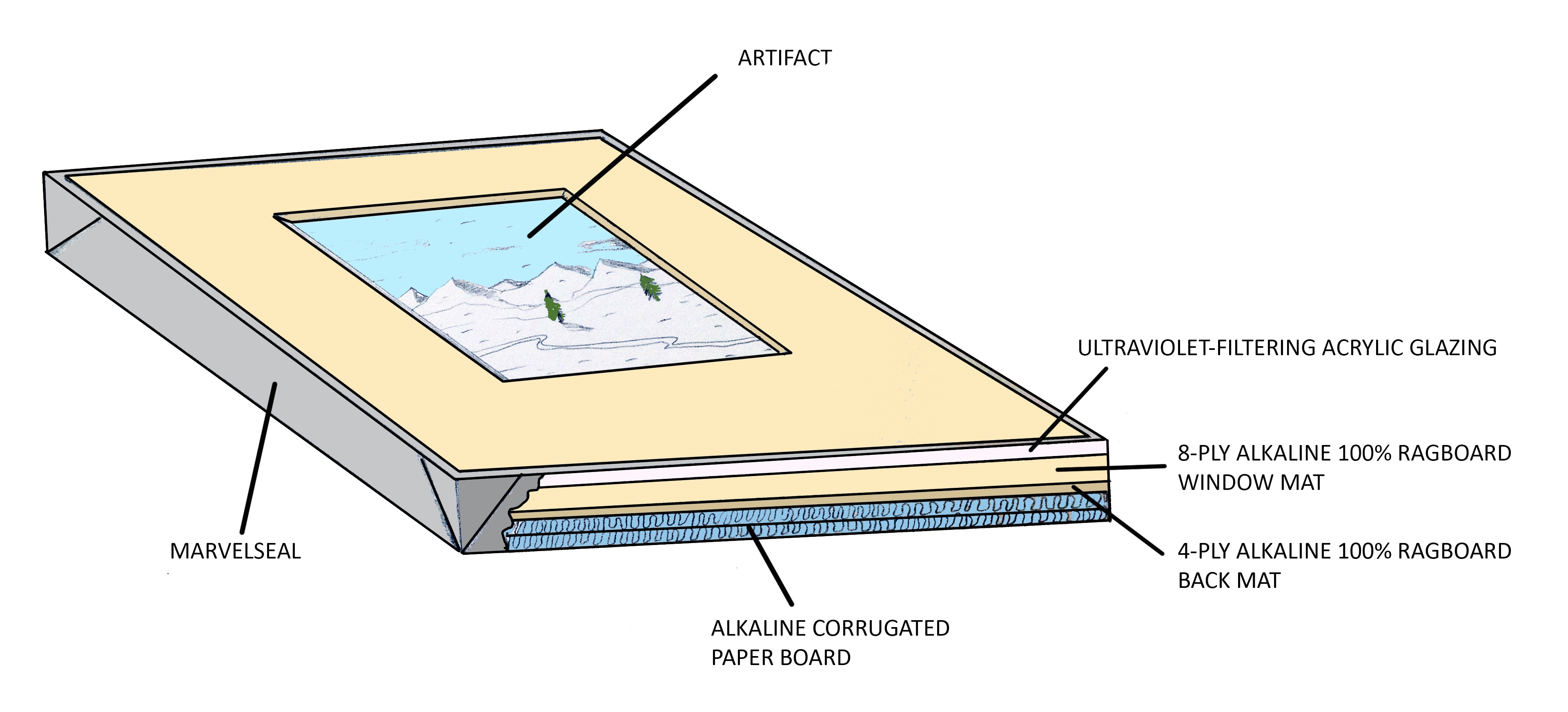Matting and Framing Specifications for Objects on Paper
Choosing appropriate materials and methods for matting and framing has significant and lasting effect on the condition of paper artifacts. Properly constructed mats structurally support and aesthetically enhance an artifact for the long-term, while poor quality materials or constructions can create disfiguring stains and distortions and even negatively affect the media. These recommendations are intended to provide specific guidance in selecting materials and methods, to best inform the investment and effort of matting and framing. Some artifacts, such as diptychs or triptychs, double-sided materials or parchment require unique consideration and design. In this case, it is always recommended to directly contact a Conservation Technician for recommendations.
MAT BOARD
Mat boards should be chemically stable, made from 100% cotton rag or purified wood pulp, and free of lignin, ground wood, and metallic particles. Mat boards used with photographs should pass the Photographic Activity Test (PAT), a predictive test of reactions between the materials and the photographs (including inkjet prints). In most cases, selecting alkaline mat boards that are buffered with 3.5% calcium carbonate to protect against acid migration and oxidation over time, is a beneficial option. However, some photographic processes, such as cyanotypes, are sensitive to alkaline environments and should be matted with neutral pH mat board.
CCAHA recommends materials that contain zeolites, molecular sieves that absorb gaseous pollutants, which can be found in Neilson Bainbridge ArtCare® mat board as well as MicroChamber® interleaving paper. The use of neutral or white shades of mat board is preferred for aesthetic reasons and to eliminate the risk of bleeding if exposed to water or excessive humidity.
Most paper artifacts that are generally in plane should be matted with 8-ply or 4-ply boards, which offer rigid support and provide space between the artifact and the glazing within a framed package. Some artifacts with planar distortions, thickly applied media, or that are very large require additional depth between the surface of the artifact and the glazing. This can be achieved with acrylic spacers wrapped with alkaline paper, or additional layers of ragboard.
HINGES OR CORNERS
An artifact should be attached to a back mat board with mulberry paper hinges or non-adhesive paper adhered with wheat starch paste, or polyester film corners. Mulberry paper is long-fibered and strong, yet thin, with no additives that may cause discoloration to the artifact. Wheat starch paste is a reversible, non-staining adhesive. The hinge should be attached to the artifact verso, dried under light weight to prevent distortion, and then attached to the back mat. As a general rule, hinges should be attached to the artifact five inches apart. The hinged artifact should always be capable of free movement at the hinges and should not be adhered directly to the mat board.
Some paper artwork and artifacts have imagery that extends to the edges of the page, and lacking margins cannot be covered by a window mat without obscuring significant detail. The decision is then often made to display the edges within the window mat. A float-mat is required and V-hinges are used: a V-shaped piece of mulberry paper is adhered to the verso of the artifact and the back mat. The aesthetic design of a float-mat is sometimes preferred with modern art and often can be used safely, however large or heavy artifacts may in fact require a window mat to be supported securely.
RIGID SUPPORT
A rigid alkaline corrugated paperboard or ragboard should be placed behind the window mat for additional support. Do not use acidic corrugated paperboard, wood, or fiberboard.
GLAZING
Glazing is recommended over the matted artifact in the framed package, to protect from ultraviolet and natural light damage, air-born debris, and pollutants. CCAHA recommends acrylic glazing instead of glass, to avoid any risk of shattering and lighten the overall weight of the framed package.
Optium Museum Acrylic® made by TruVue, Inc. combines anti-reflective and anti-static properties with ultraviolet filtering and can be used with pastels and other friable media.
SEALED PACKAGE
CCAHA recommends a sealed package for exhibition housing, a design that utilizes a Marvelseal® laminate material of foil, nylon, and polyethylene to create a micro-chamber around the matted object and can be inserted directly and discreetly into a frame. The sealed package keeps out particulate matter and pollutants; provides a barrier to rapid fluctuations in temperature and relative humidity in the environment; and protects against improper handling.

FRAME
A frame should be deep enough to accommodate the glazing, matted artifact, and backing board without extreme pressure. Period frames that are too shallow can often be modified by a skilled frame maker or frame conservator to provide adequate depth.
HANGING HARDWARE
Many frames in home settings can be hung with coated picture wire attached to the side rails with screw eyes. Heavy frames may require D-rings on the side rails and two points of attachment to the wall. Museums generally use security hardware that requires special installation. Do not use saw-tooth hangers on the top rail.
Updated July 2022.